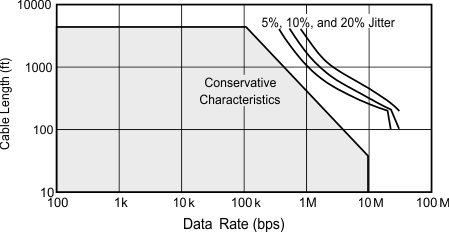ZHCSIV2C September 2018 – September 2019 ISO1500
PRODUCTION DATA.
- 1 特性
- 2 应用
- 3 说明
- 4 修订历史记录
- 5 Pin Configuration and Functions
-
6 Specifications
- 6.1 Absolute Maximum Ratings
- 6.2 ESD Ratings
- 6.3 Recommended Operating Conditions
- 6.4 Thermal Information
- 6.5 Power Ratings
- 6.6 Insulation Specifications
- 6.7 Safety-Related Certifications
- 6.8 Safety Limiting Values
- 6.9 Electrical Characteristics: Driver
- 6.10 Electrical Characteristics: Receiver
- 6.11 Supply Current Characteristics: Side 1(ICC1)
- 6.12 Supply Current Characteristics: Side 2(ICC2)
- 6.13 Switching Characteristics: Driver
- 6.14 Switching Characteristics: Receiver
- 6.15 Insulation Characteristics Curves
- 6.16 Typical Characteristics
- 7 Parameter Measurement Information
- 8 Detailed Description
- 9 Application and Implementation
- 10Power Supply Recommendations
- 11Layout
- 12器件和文档支持
- 13机械、封装和可订购信息
9.2.2.1 Data Rate and Bus Length
The RS-485 standard has typical curves similar to those shown in Figure 33. These curves show the inverse relationship between signaling rate and cable length. If the data rate of the payload between two nodes is lower, the cable length between the nodes can be longer.
 Figure 33. Cable Length vs Data Rate Characteristics
Figure 33. Cable Length vs Data Rate Characteristics Applications can increase the cable length at slower data rates compared to what is shown in Figure 33 by allowing for jitter of 5% or higher. Use Figure 33 as a guideline for cable selection, data rate, cable length and subsequent jitter budgeting.